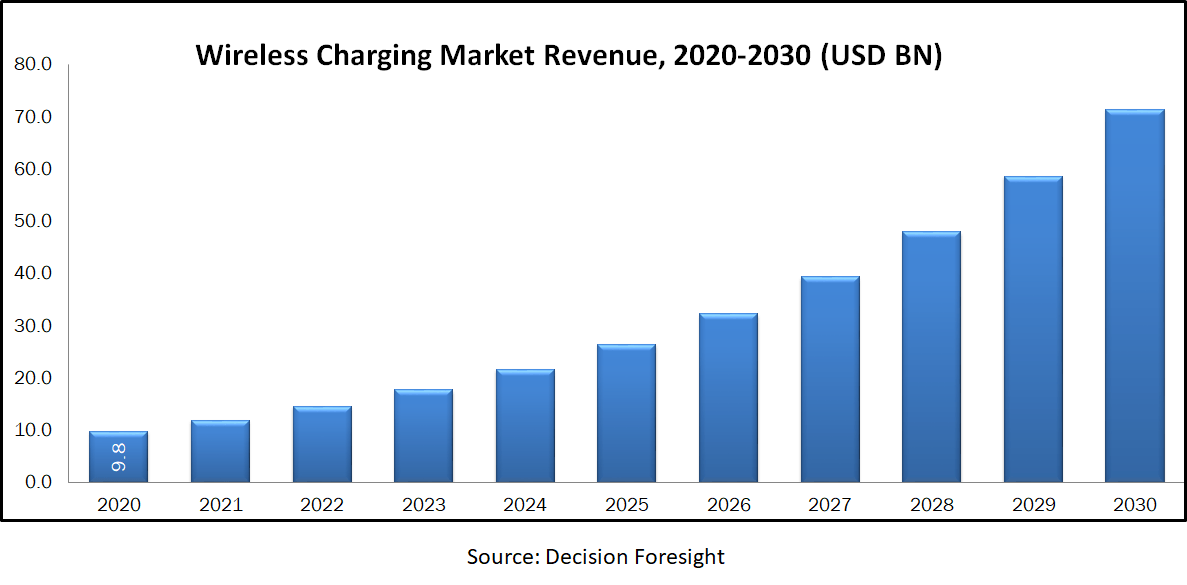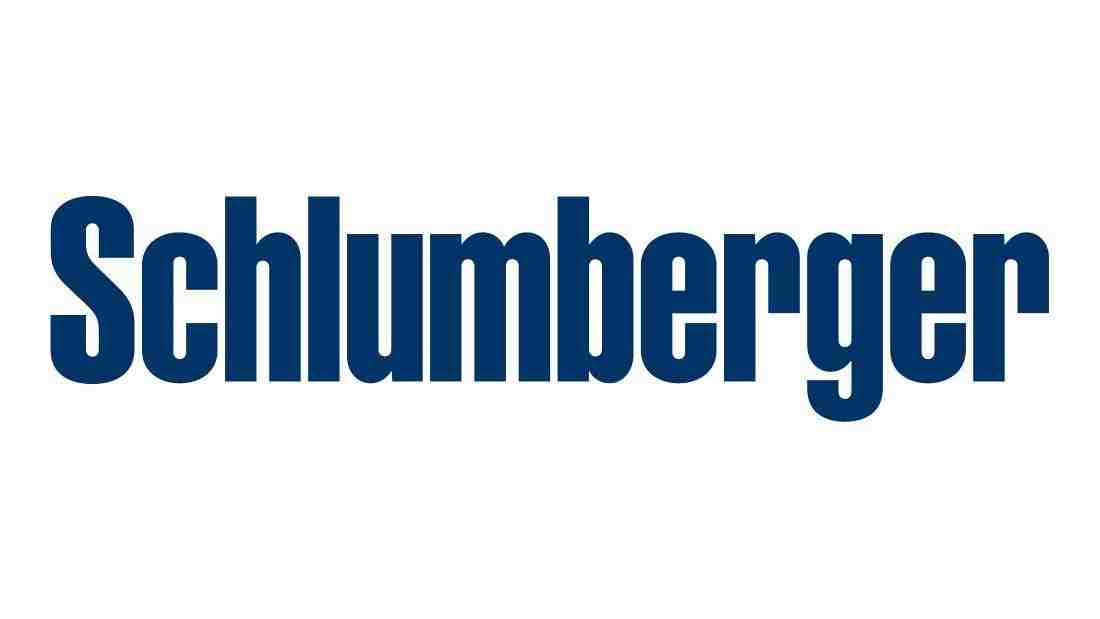Wireless Charging is a process of electric power transfer from charging device/s or node to receiver devices powered by battery/ies and also equipment/s electrically without tangible wired power transfer. Wireless Charging Equipment consists of two components a charging system (Transmitter) which transmits electric power through the electromagnetic field and a Device Inbuilt Receiver which charges the battery. The Global Wireless Charging Market is estimated USD 9.79 billion in 2020 and anticipated to reach USD 71.4 billion by 2030 at a CAGR of 22% during the forecast period. However, it has many industrial applications such as electric vehicles, handheld terminals, contactless charging of subsea vehicles, factory automation, etc. Industrial applications of wireless charging demand the workability of portable equipment and its wireless charging system in the harsh conditions. With the absence of wired power transmission, a wireless charging system can be impregnable to the industrial environment. Moreover, due to the absence of wired power transfer, the usage of wireless charging is safe from hazards such as electrocution & fire escalation because of stray spark during connecting & disconnecting wired power transfer cable. In terms of applications, consumer electronics is the dominant industry in the market due to rapid and efficient consumer electronics manufacturing. Manufacturers have been aiming mobile & rechargeable consumer electronics such as laptops and smartphones.
Market Segmentation:
On the basis of technology, the global wireless charging market is segmented into the inductive charging system, resonant charging system, microwave wireless charging system, radiofrequency charging system, and others. Based on the type of application, consumer electronics, automotive, industrial, healthcare, and aerospace & defense are the categories which this market caters to. Based on the type of standard in which the wireless charging system available is categorized as Wireless Power Consortium (WPC), Power Matters Alliance (PMA), and Alliance for Wireless Power (A4WP), open dots. On the basis of implementation, this market is bifurcated into the transmitter and receiver. On the basis of the transmission range of the charging system, this market provides products in these categories such as short, medium and long. Based on the distribution channel type, this market is segmented into modern retail stores, specialty stores, after-sales market, and original equipment store. Geographic breakdown and analysis of each of the aforesaid segments includes regions comprising North America, Europe, Asia-Pacific, and RoW.
Market Dynamics and Factors:
Increased Mobility, ease of handling, rise in disposable income throughout the world, expanding expenditure on electronic gadgets, flexibility, protection against electric shocks, a convenient power transfer method for the Internet of Things (IoT) proliferation are stimulating the demand and market growth. Moreover, wireless charging technology integration in automobiles, embedded wireless charging in consumer electronics (such as wearable devices, tablets, and smartphones) and increased healthcare segment applications are driving awareness in the market about wireless power transmission technology. The aforementioned factors are the growth drivers for the global wireless charging market. Longer duration of charging, limited portability, lack of standardization of technology, limited range per charge (in case of electric vehicles application), charging potentials are the factors restraining the growth in this market. Increased IoT adoption & smart devices, technological advancement in wireless charging systems across the sectors, adoption of wireless charging & electric vehicle in automobiles, rising infrastructural developments (such as smart cities in developed & developing countries, wireless charging stations for electric vehicles across the globe), declining conventional methods (such as reliance on wired power transfer & fossil fuels in case of vehicles) are the factors that bring numerous opportunities for the market growth. Cost of up-gradation to wireless technology from conventional methodologies across sectors in developed & developing countries and also across the world.
Geographic Analysis:
North America holds prominence as compared to other regions in the market with expected to grow nearly at CAGR 14% during the forecast period. This region is driven by a range of innovative breakthroughs in the wireless power transfer. For example, the launch of the Q4 wireless bundle to Q3 wireless chargers which provides optimum charging speed coupled with compactivity and portable size was witnessed in the region. Furthermore, the rising demand for electric vehicles has stimulated manufacturers to invest in safer & efficient charging systems. The European market is predicted to grow a CAGR of 28.69% approx. which is 3rd highest market revenue in this market during the forecast period. Factors such as high urban penetration, high adoption of wireless power transmission, the fastest-growing electric vehicle wireless charging market & related infrastructure and huge scope in medical equipment are stimulating potential market growth opportunities for the market expansion. The Asia Pacific is the largest revenue generator for the global market which is expected to grow with a CAGR of 42.94% approx... APAC is mainly segmented on the basis of applications, technology, and components. Various factors such as increased penetration of smartphones, the large consumer electronics base, rising wireless computing devices adoption are primary growth drivers. Moreover, suppliers for ICs required in wireless power transmission are developing miniaturized & high energy transfer efficient ICs. Amongst other regional markets, China is leading the market but also Japan, India, South Korea, and Australia are the major revenue contributors to the regional market. As in the Middle East region, the growth in the market driven by Gulf Countries & heavy investment by Israel but in Africa, the market is in the nascent stages of adoption. Latin America is expected to grow in the forecast period, as it lacks the adoption of wireless power transmission into the masses.
Competitive Scenario:
These are the key players in the market which drive the market demand such as Qualcomm Inc., Oregon Scientific Inc., Integrated Device Technology Inc., Samsung Electronics Co. Ltd., Leggett & Platt Inc., Texas Instrument Inc., Powermat Technologies Ltd., Witricity Corporation, Murata Manufacturing Co. Ltd., Energizer Holdings Inc., Convenient Power HK Ltd., Mojo Mobility Inc., NXP Semiconductor N.V., TDK Corporation, Semtech Corporation.
Wireless Charging Market Report Scope
| Report Attribute | Details |
| Analysis Period | 2020–2030 |
| Base Year | 2021 |
| Forecast Period | 2022–2030 |
| Market Size Estimation | Billion (USD) |
| Growth Rate (CAGR%) | 22 % |
|
| By Technology (Inductive charging system, Resonant charging system, Microwave wireless charging system, Radio Frequency charging system and others), By Application (Consumer electronics, Automotive, Industrial, Healthcare, Aerospace & Defense), BY Standard (Wireless Power Consortium (WPC), Power Matters Alliance (PMA), Alliance for Wireless Power (A4WP), Open Dots), By Product type (Transmitter, Receiver), By Transmission Range (Short, Medium, Long) |
| Geographical Segmentation | North America (U.S., Canada, Mexico) Europe (UK, Germany, Italy, France, Rest of Europe), Asia-Pacific (China, Japan, India, Australia, Rest of APAC), South America (Brazil, Argentina, Rest of SA), MEA (UAE, Saudi Arabia, South Africa) |
| Key Companies Profiled | Qualcomm Inc., Oregon Scientific Inc., Integrated Device Technology Inc., Samsung Electronics Co. Ltd., Leggett & Platt Inc., Texas Instrument Inc., Powermat Technologies Ltd., Witricity Corporation, Murata Manufacturing Co. Ltd., Energizer Holdings Inc., Convenient Power HK Ltd., Mojo Mobility Inc., NXP Semiconductor N.V., TDK Corporation, Semtech Corporation. |







